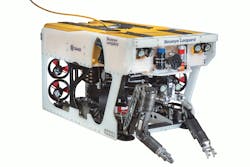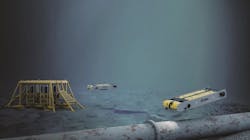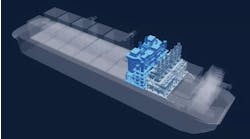Editor's note: This cover story first appeared in the July-August 2023 issue of Offshore magazine. Click here to view the full issue.
By Ariana Hurtado, Editor and Director of Special Reports
A vast majority of operators and developers are investing in autonomous underwater vehicles (AUVs) and remotely operated vehicles (ROVs) as they seek to optimize production, decrease emissions and enhance safety during operations.
In a recent interview with Offshore, Oceaneering’s senior vice president of business development and chief commercial officer, Earl Childress, said, “Remote operations are continuously evolving to address challenges in the offshore energy industry by increasing efficiency, reducing costs, minimizing risks and lowering the environmental impact of operations. Technological advancements play a crucial role in these improvements.”
So where are the latest hot spots for ROV and AUV utilization in the offshore energy space? The following highlights the latest remote robotics projects and technologies being used and where they’re being launched.
Offshore Poland
Saab Seaeye, a provider of electric underwater robotics technology, specializes in e-robotics systems for the oil and gas industry as well as for surveying, building and maintaining turbine structures and their interconnections in the renewables sector.
In May of this year, LOTOS Petrobaltic ordered a Seaeye Leopard vehicle to help service subsea infrastructure connected to the B3 and B8 oil fields in the Polish sector of the Baltic Sea.
The Leopard can perform inspection of underwater structures, construction cleaning, cutting, dredging for inspection, and provide support for head installations and diving teams.
Saab Seaeye says its design allows for expansion and different configurations to perform a broad range of measurements and underwater works and inspections. For the Baltic campaign its survey package will include a multi-beam sonar, LIDAR and pipe tracker.
At the time of the news release, LOTOS Petrobaltic was preparing its supply vessel, Bazalt II, to serve as a dedicated operational platform for the Leopard, including adapting it to receive the LARS system and the customized control cabin.
In addition, Saab announced in June that it received an order from marine geophysical company PXGEO for its Sabertooth AUV. The deliveries will take place from 2023 to 2025. The order includes more than 20 Sabertooth vehicles. These will form part of PXGEO’s MantaRay solution for offshore seismic data acquisition and will be used for deployment and recovery of equipment during ocean bottom surveys. The companies aim to make offshore seismic data acquisition fully autonomous. Saab did not specify where the surveys would take place.
Offshore Germany
Backed by private equity firm Bluewater, underwater ROV provider ROVOP recently secured a $25 million investment from Cordiant Capital. ROVOP specializes in offshore equipment and services, such as installation of wind farm infrastructure, gas pipelines and undersea internet cables. The financial support aims to assist ROVOP continue to invest in its fleet infrastructure, employees and to secure new contracts for newbuild construction, decommissioning, surveillance and maintenance services. ROVOP says this investment builds on existing credit facilities in solar and wind power and upstream gas in Greece, Romania, and Turkey, respectively.
“Due to recent contract awards, ROVOP are actively sourcing experienced ROV Pilot Technicians with an extensive amount of Sub Atlantic and Seaeye experience,” ROVOP posted on its LinkedIn in early July.
The company announced in June that it recently mobilized a work class ROV system to carry out unexploded ordnance (UXO) works for Boskalis Hirdes to support planned wind farm development work. The 150-HP, 3,000-m depth rated WROV system, which is designed for high performance, reliability and maintainability, mobilized from ROVOP’s Aberdeen headquarters before project commencement offshore Germany. “UXO works are a crucial stage in the development of offshore wind as sites are made safe for construction activities and operation,” the company stated. “ROVOP have significant experience in the safe identification of UXO targets and remedial action required thereafter.”
Caribbean Sea
A few months ago, ROVOP had another work class ROV mobilizing from its Aberdeen headquarters. The system traveled to the Port of Aberdeen harbor to mobilize onto the multirole diving support vessel, Boka Topaz, for partner Boskalis Subsea Services. The vessel and system then transited to the Caribbean Sea for local operations.
Asia-Pacific
In January of this year, ROVOP began its subsea operations contract with Mermaid Subsea Services (Thailand) Ltd. offshore Malaysia. ROVOP mobilized its newly acquired Schilling HD 150-HP work class ROV onboard the Van Gogh DP2 diving support and construction vessel. The ROV system supported Mermaid Subsea's full range of subsea activities from inspection, repair and maintenance (IRM) as well as construction interventions, field maintenance and decommissioning.
That same month Kawasaki Heavy Industries completed offshore verification tests with TotalEnergies using an AUV to measure the electrical potential of subsea pipelines. The close-range inspections were performed offshore Awaji Island in Japan’s Hyogo Prefecture.
Kawasaki has been developing what it claims is the world’s first AUV with a robot arm for subsea pipeline inspections, named SPICE (Subsea Precise Inspector with Close Eyes). The development follows increased demand for subsea pipeline maintenance in offshore oil and gas fields.
Offshore Angola
Chevron recently highlighted its newest tool for subsea inspections: mini ROVs. The company partnered with tech company BeyonC to use mini ROVs that combine a vehicle made by JM Robotics with FiGS sensor technology made by FORCE Technology. Chevron said mini ROV-based inspections allow the company to get a thorough and accurate assessment of its assets without sending in divers or a work class ROV.
Chevron first tested the mini ROVs in Angola in 2020. It has now successfully performed more than 30 structure surveys with the mini ROVs equipped with FiGS sensors, and plans are underway to conduct more than 150 structure surveys over the next three years in the region.
Offshore Brazil
Fugro has been busy offshore Brazil, partnering with Petrobras in March to perform the country’s first remote subsea inspection survey.
This technology trial was carried out by the companies under an existing multiyear contract with the aim of minimizing risk and improving sustainability during IRM projects.
Fugro used an ROV deployed from the Fugro Aquarius vessel to conduct the survey. Onshore personnel piloted the ROV from an operations center in Aberdeen, Scotland, instead of from the vessel. Fugro said the approach was informed by its remote ROV piloting experience in other parts of the world and was accomplished using a high-speed datalink provided by Petrobras. Looking ahead, the companies said remote ROV piloting for future projects could help Petrobras reduce crew personnel deployed to the field, which would lead to safer operations and a reduced carbon footprint.
More recently, Petrobras partnered with Nauticus Robotics, a developer of autonomous robots using artificial intelligence for data collection and intervention services, to deploy the Aquanaut autonomous subsea robot for offshore activities. Aquanaut will be utilized in Petrobras’ deepwater production field using supervised autonomy for infield inspection services. Nauticus said the contract consists of about two months of subsea inspection time and is one of the largest awarded contracts of its kind to date worldwide.








